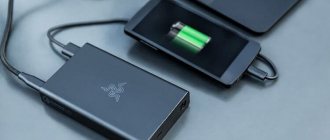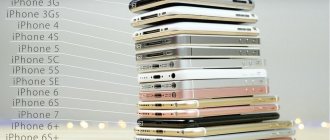Global version (Global, EU, Eurotest, CE)
This marking is given to devices intended for the international market. For example, smartphones come with the same components and may differ in EU and UK “plugs” - different countries have their own power supply standards. EU Plug is a familiar Euro plug for Russians that does not require any adapters. US (USA) and AU (Australia) forks are rare.
The operating system of the device already has Google services pre-installed and supports the Russian language. I would like to add that if previously ]Xiaomi[/anchor] released the same firmware for all global devices, now the manufacturer has started releasing different firmware. If I'm wrong, correct me in the comments.
Samsung has a slightly different situation, for example: for the American market, Korean smartphones come with Qualcomm Snapdragon processors, and for all other markets with Exynos chips.
The instructions in the box for the global version are usually provided in the language of the country for which the device is intended.
The most important feature of the Global version of the smartphone is that the device operates in all ranges of cellular networks, unlike the Chinese version, which has limitations.
What is the danger of a smartphone with Asian firmware?
Initially, these devices have neither Russian nor English, only Chinese characters. In order for a familiar language to appear on a mobile phone, it has to be flashed to an operating system with the Russian language. It may seem that there is nothing special about this procedure. In reality, an unofficially installed operating system is unstable, since its installation was not carried out by professionals who knew the device inside and out, but by folk craftsmen whose skills cannot be verified.
Sometimes there are cases when a reflashed smartphone not only does not work correctly, but may not turn on at all. Such a device cannot be “reanimated”.
Chinese version (China, CN)
As you already understand from the title, this marking is placed on smartphones only for the Chinese market. The firmware (China ROM) of the gadget contains only two languages: Chinese and English. In addition, the Chinese version does not have pre-installed programs from Google, including the Play Market. In order to install these services, you need a little skill in rooting your Android device.
In some cases, it happens when a global version of the firmware is installed on a Chinese device. Accordingly, the list of supported languages is increasing, including Russian. For example, in a Xiaomi (CN) smartphone, before installing the Global ROM firmware, sellers or a service center will unlock the bootloader. After this, you can safely install the firmware.
All documentation and the box supplied with the kit contains hieroglyphs. The charger is manufactured according to Chinese standard. Therefore, an additional adapter for a Euro plug is purchased. As for warranty service, such obligations are assumed by the store where you purchased the device.
Don’t forget, devices produced for the Chinese market support LTE frequencies according to the Band 1, 3, 5 and 7 standard, and for European countries the Band 1, 3, 5, 7, 20, 38, 39, 40, 41 standard is required. In Russia, the B20 standard serves as an auxiliary standard; for a metropolis it is not particularly important, but in small cities and sparsely populated areas it will be necessary. The absence of these bands in the smartphone may affect the level of the cellular network signal or complete loss of connection.
A small clarification, if you buy a Chinese device even with a global version of the firmware (Global ROM), then the smartphone will still not support the B20 standard. The GSM module does not physically support these bands.
WHAT IS LTE BAND 20?
In total, there are 70 LTE “bands”, which differ from each other in frequency and some other parameters, but at the moment 5 bands are used by Russian operators:
- 3 in the 1800 MHz FDD band;
- 7 in the 2600 MHz FDD band;
- 20 in the 800 MHz FDD band;
- 31 in the 450 MHz FDD band;
- 38 in the 2600 MHz TDD band.
The Big Three widely use 3, 7, 20 and 38 bands in Russia, and combine them depending on several factors. The higher the population density and activity, the higher the frequency is required, since it is necessary to provide high capacity and good speed. In the centers of megalopolises, in business districts, in places with high tourist activity, 3, 7 and 38 bands are usually used. In regions where population density and infrastructure investment are lower, Band 20 is used, since in it the base station can cover a fairly large radius (up to 13.4 km) with good penetration into buildings, while the speed does not suffer, since there is much more Fewer users need LTE. But band20 is mainly used either in completely sparsely populated areas or in large cities as an additional range . That is, even if your device does not support band20, you will not be left without 4G, since the territory will additionally have band 3-7-38 coverage.
Russian version (Rostest, RST, EAC)
Any device supplied from abroad, for example: a smartphone, wearable electronics and other type of gadget, undergoes mandatory certification for the Russian Federation, receiving the “Rostest” marking or, in a new way, “EAC”. Essentially, this is the same global version with a Euro plug, plus all the documentation is in Russian.
The EAC mark - also known as Rostest - is printed on the device itself and on the packaging box. The most important and only advantage of such certification is warranty repairs at any authorized service center in Russia. Don’t forget, you need to pay for services, and the buyer receives a 15-20% increase in the cost of the gadget.
Comparison table
| Global | China | Rostest | Eurotest | |
| Instructions | En | Ch | En, Ru | En, Ru |
| Guarantee | Seller | China | RF | Seller |
| Russian language | Eat | No | Eat | Eat |
| Charger | Euro, UK or US | China | Euro | Euro, UK, US + adapter |
| Firmware | Global ROM | China ROM | Global ROM | Global ROM |










